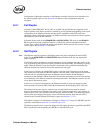
Software Developer’s Manual 161
Ethernet Interface
The normal rules for IPG are followed during packet bursting after the first packet has met the
minimum slot time requirements, with the exception that the Inter Frame Content (IFC) is
extension symbols rather than IDLEs. Under some circumstances, it might be desirable to extend
this IPG time during a burst. This can be done via the
AIFS field in the AIT register. See Section
13.4.35.
8.5 Auto-Negotiation and Link Setup
1
Configuration of the link can be accomplished by several methods ranging from software forcing
the link settings to Auto-Negotiation by the internal PHY. Section 8.6.1 describes the process of
bringing the link up including configuration of the MAC and PHY, as well as the various methods
of determining duplex and speed configuration.
The PHY performs Auto-Negotiation per 802.3ab clause 40 and extensions to clause 28. Link
resolution is obtained from the PHY after the link has been established via the MDIO interface, by
the controller via specific input signals from the PHY or by the controller’s specific auto detection
functions.
Upon power up, or device reset via the RST# input, the controller initiates Auto-Negotiation based
on the default settings in the Device Control and Transmit Configuration Word registers, as well as
settings read from the EEPROM. If enabled in the EEPROM, the Ethernet controller will immedi-
ately perform Auto-Negotiation.
8.6 Auto-Negotiation and Link Setup
2
Configuration of the link can be accomplished by several methods ranging from software forcing
the link settings to Auto-Negotiation by either the MAC (Internal Serdes mode) or the internal
PHY (GMII/MII mode). The following sections describe the process of bringing the link up
including configuration of the MAC and PHY, as well as the various methods of determining
duplex and speed configuration.
The process of determining link configuration differs slightly depending on the Ethernet controller
type and version. In Internal Serdes mode, the MAC performs Auto-Negotiation per clause 37 of
the 802.3z standard. The transceiver used in this mode (the SerDes) does not participate in the
Auto-Negotiation process as all aspects of Auto-Negotiation are controlled by the MAC.
For internal PHY mode, the PHY performs Auto-Negotiation per 802.3ab clause 40 and extensions
to clause 28. Link resolution is obtained from the PHY after the link has been established via the
MDI/O interface, by the Ethernet controller via specific input signals from the PHY, or by the
Ethernet controller’s specific auto detection functions.
The method for configuring the link between two link partners is highly dependent on the mode of
operation as well as the functionality provided by the specific physical layer device (PHY or
SerDes). For Internal Serdes mode, the Ethernet controller provides the complete 802.3z PCS
function on-chip. For GMII/MII mode, the PCS and Auto-Negotiation functions are maintained
within the PHY.
1. 82541xx, 82547GI/EI, and 82540EP/EM only.
2. Applicable to the 82546GB/EB, 82545GM/EM, and 82544GC/EI only.


















